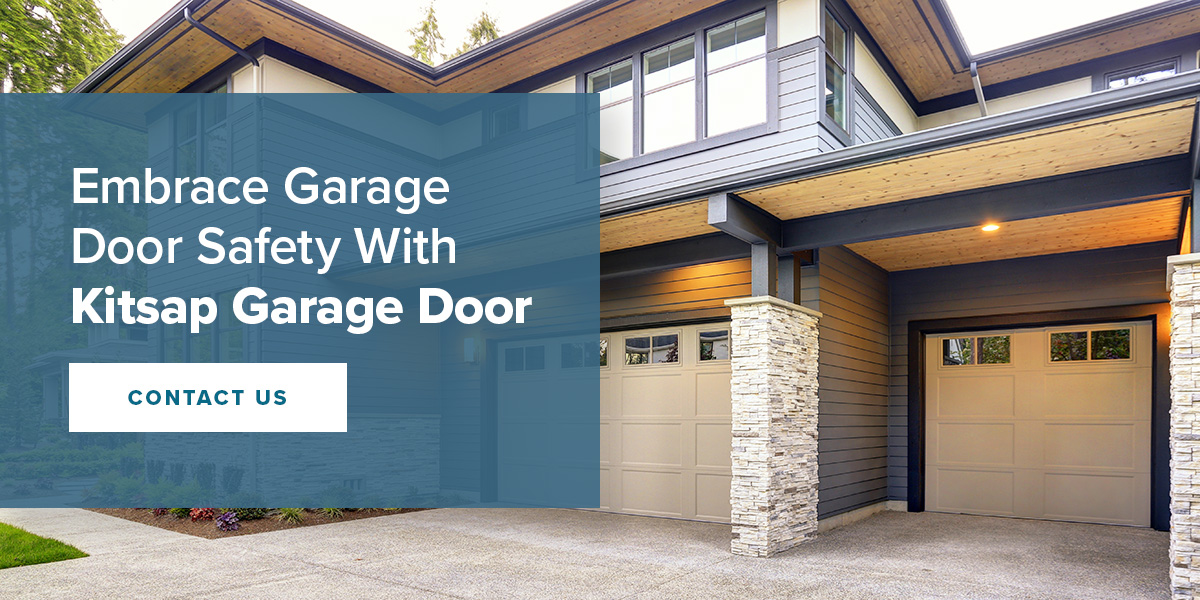Garage Door Safety Tips
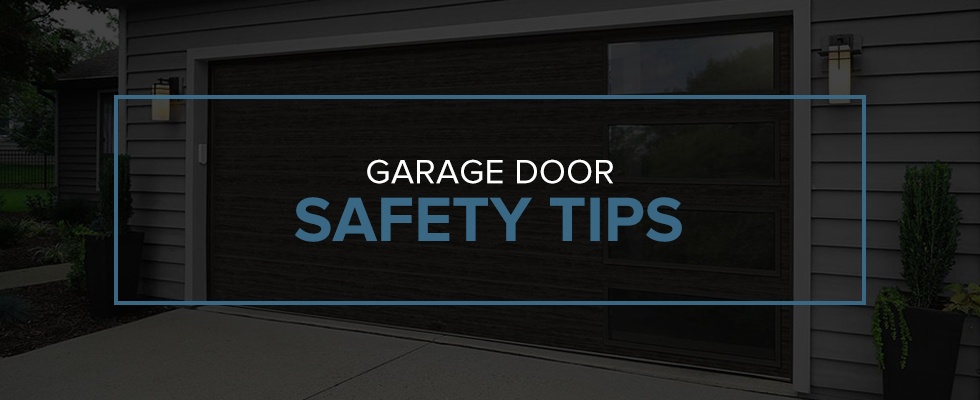
Considering garage door safety is essential. Keep your household safe by taking precautions such as performing visual inspections, using unique opener codes and scheduling professional maintenance.
Garage doors can be very dangerous. While technology has improved garage door safety features, following standard protocols is an easy way to prevent unwanted accidents.
Understanding potential risks and how to mitigate them will help your family enjoy more secure garage door operation and greater peace of mind.
Why Is Garage Door Safety Important?
A garage door is essential to your home’s security and provides convenience, but it’s also a heavy, tension-fueled machine made of metal parts. It covers a considerable amount of a home’s surface area and can be a safety risk to those living inside.
However, accidents and breakdowns aren’t the only safety concerns — your garage door protects your space against unwanted entry. Increasingly, burglars are using the garage to access homes they want to steal from.
Operating your garage door with caution and prioritizing maintenance is crucial to ensuring the safety and security of your loved ones. By understanding how your automatic garage doors operate, as well as the safety mechanisms available to you, you can reduce the likelihood of anyone breaking into your garage and gaining access to your home.
What Are the Top 8 Garage Door Safety Tips?
Whether you’ve had a garage door for 20 years or you’ve just moved into a home with a garage, it’s always a good time to practice garage door safety to protect yourself and those you love.

The most important thing to remember is this — a garage door is a moving piece of equipment. It’s heavy and has several moving parts that can wear out, just like any other appliance in your home. Follow these garage door tips and tricks to keep you and your loved ones safe.
1. Carefully Guard Remotes
One of the most important garage door safety rules applies to the most convenient feature of any automatic garage door — the remote. If you keep a garage door remote control in your car for easy access, store it out of sight or bring it inside at night so potential burglars can’t use it to access your home. When the remote is in your car, always keep your vehicle locked. Home invasions using the garage as an entry point are becoming increasingly common, so it’s crucial you ensure your remotes and access codes don’t fall into the wrong hands.
Homeowners with a detached garage tend to be more relaxed about this since burglars can’t gain entry to their house via the garage. However, vigilance is vital even with a detached garage. Consider the expensive lawn equipment and vehicles stored in your detached garage. Losing those to thieves could be a significant financial blow to just about anyone.
It’s also important to keep remotes away from young children. If a child can open or close the garage door without an adult nearby, they may put themselves in danger should the door malfunction. It can also give them a way to leave the house unattended and become lost.
It’s tempting to hand the remote to a young child to allow them to push the button to open the garage upon your return home, but teaching them how to use the remote when they’re young can also lead to them taking the remote and using it when they are unsupervised. Refrain from allowing young children to operate the garage door remotes and have any wall remotes installed at least 5 feet from the floor to prevent children from reaching them.
2. Familiarize Yourself With Garage Door Operation and Built-In Safety Features
It’s easy to assume that an automatic garage door just goes up and down on command. If you’re like many homeowners, you probably didn’t look at the owner’s manual that came with your garage door. However, taking the time to familiarize yourself with how your garage door works is an important way to protect your household. Understand the different components of the door, the garage door opener’s reversing mechanism, how high garage door sensors should be and other safety features. When you get to know the built-in safety features and what they can do to protect you in a dangerous situation, you reduce the risk of injury.
All garage door openers made after 1991 are legally required to have a reverse feature — test your garage door opener’s reversing feature for yourself. Place a roll of paper towels or an empty cardboard box on the floor underneath the middle of the door while the door is open. Then, hit the close button on your remote. If the auto-reverse feature is working correctly, the door should stop and then go back up as soon as it touches the object in its path.
One of the most critical features to familiarize yourself with is the emergency release feature. It’s typically the red handle hanging from your garage door opener. This feature allows you to raise or lower your door manually in a power outage. It’s critical to understand how the emergency release works if you live in an area where you may have to evacuate due to a natural disaster. You want to be sure you can get your vehicle out of the garage during a crisis. Knowing how this emergency feature works and practicing using it could save your life one day.
Practicing using the emergency release feature can also alert you to potential problems with the door itself. If you can’t raise the door on your own, this may be a sign that the tracks or spring needs to be repaired or replaced. Or, it could be a sign that it’s time for a new garage door altogether.
3. Monitor the Door’s Operation
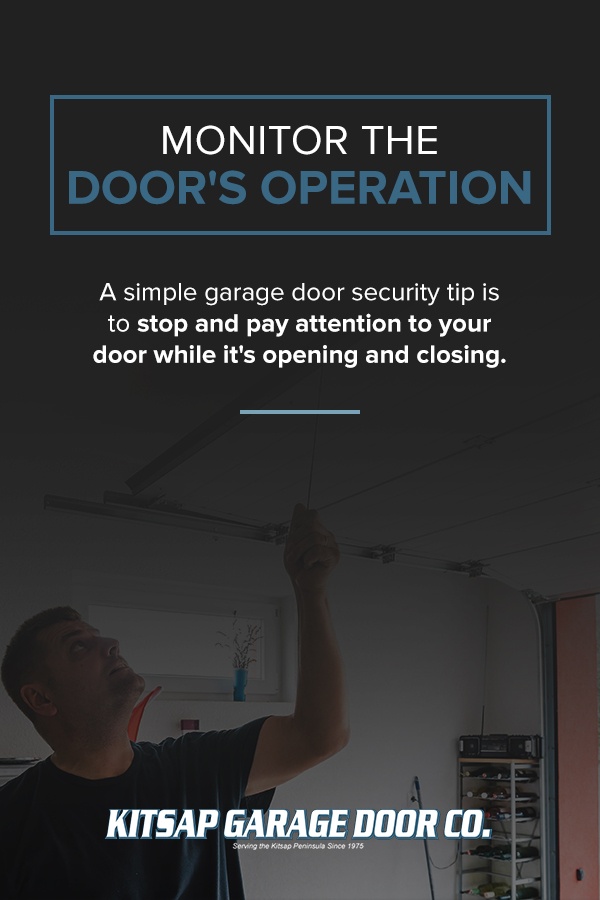
A simple garage door security tip is to stop and pay attention to your door while it’s opening and closing. It’s important to ensure your garage door goes all the way up and down each time you use it. Even if you’re in a rush, it’s best to take some time to watch your door as it goes down. Observe how it opens and closes. Does it move up quickly or slowly? Do you hear noises as it moves? Is it sensing objects in its path? By making these observations, you can get a better understanding of how the door works, and you’ll also be more likely to spot potential problems before they become an emergency issue.
4. Perform a Visual Inspection
Take a few minutes to walk around the outside and inside of your garage door. Note any scratches, cracks or dents that might be problematic. Check the safety sensors on either side of the door to ensure the lenses are clean and no objects block them. Next, check the springs, pulleys and rollers for signs of wear and tear.
If you find any problems, refrain from turning this into a DIY project. One of the biggest mistakes many homeowners make is assuming they can repair a garage door themselves. Garage door repair is hazardous if you aren’t specially trained to handle the door and its weight. If you suspect a problem, call a professional garage door repair company to evaluate the situation and complete the repairs.
Watching the door is also essential for home safety. If you speed away from the house before the garage door completely closes but your sensors pick something up and send the door back up, your door could remain open all day, leaving your home vulnerable to break-ins. Even when you’re in a rush, take the time to watch the door as it descends to ensure that it goes all the way down properly and locks in place before you drive away.
You should also conduct monthly inspections of your garage door and its moving parts. Check the cables, rollers, springs, pulleys and bolts and read through the user manual to ensure everything functions correctly. Doing this can help you detect wear and tear before it becomes a larger issue.
5. Keep Out From Under Your Door While It Is Moving
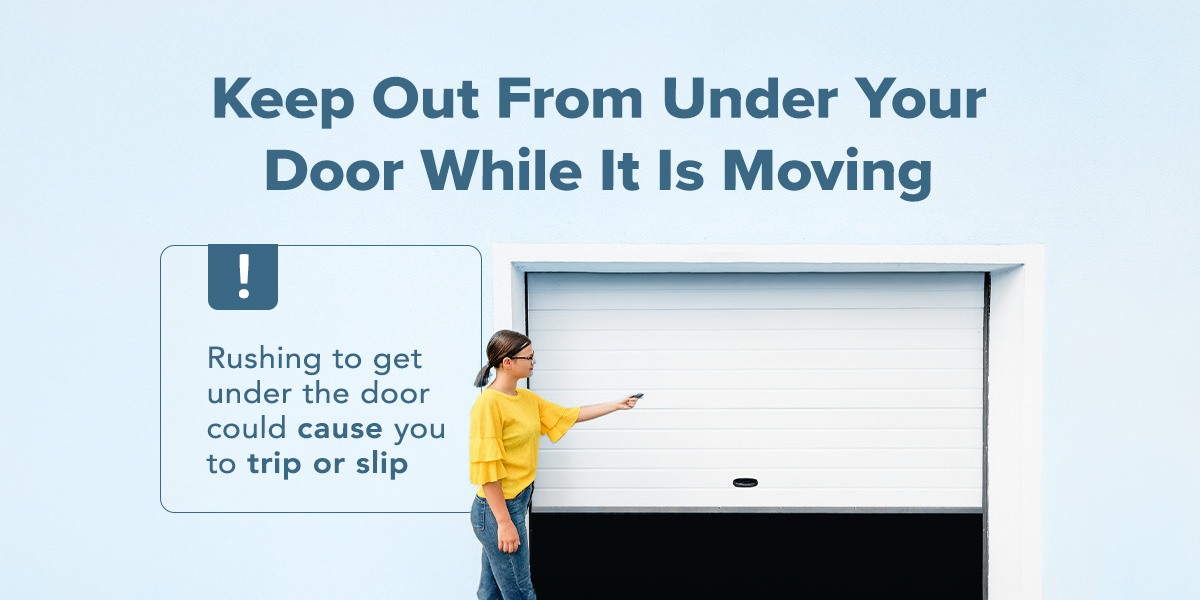
These days, safety sensors can tell if you run under the door while it’s moving. If they’re doing their job, your movement will cause the door to stop and go up. However, it’s still a good idea to avoid going under the door while it’s moving up or down. Rushing to get under the door could cause you to trip or slip. Or, it could set a bad example for children watching you do this. A child could watch you and try to emulate your behavior, resulting in them getting injured by the door or under the door.
While it may not seem like a big deal to duck under a garage door while it’s rising, it can have serious consequences. Most of the time, this won’t do anything, but any foreign movement can trigger the motion sensors and signal the door to do something other than open. In some rare cases, this has caused the door to stop or start back down while someone is still under it. Rather than risk this happening to you, it’s best to wait for the door to get all the way up before you walk under it.
Homeowners should also ensure the garage is free of pets or children before opening or closing it. They should also educate their children on the importance of staying clear of the garage door when it’s moving to avoid accidents from occurring.
6. Have a Unique Door Opener Code
In the past, potential burglars could use a scanner to pick up the code your remote used to signal your garage door opener. They didn’t need the remote — just the code — to enter your home. Because of that, many of today’s garage door openers are programmed with rolling code technology, which changes the code between each use. When the code changes, it changes in both the garage door opener and your remotes, so you never notice it. So, it’s nearly impossible for someone else to obtain the code and access your garage.
Some garage door openers offer an option to assign user-specific or one-time codes that allow delivery drivers or visitors access on a case-by-case basis. This way, you can give someone access when needed, but you don’t have to worry that they’ll return or regain entry when you don’t want them to. This is also helpful if you employ a pet walker or cleaning professional who periodically needs to gain access to your house.
Some openers also come with advanced technology that allows you to control your garage door opener with an app, reducing the need for remotes or codes that may fall into the wrong hands. These apps even allow you to open your garage door from wherever you are, so you are the only one granting access to the people who need it. Most of these smart door apps also allow you to monitor whether your garage door is open or closed.
Regardless of what kind of door opener you have, it’s also a good idea to deactivate it if you plan to be gone for vacation, a business trip or any extended period. Doing this prohibits anyone from gaining electronic access to your garage while you’re away and gives you greater peace of mind.
7. Have a Professional Perform Maintenance
Homeowners can and should perform regular checks on their garage doors. Look for cracks, dents or damaged areas and check the weather stripping for cracks or tears. Inspect the spring and tracks for signs of damage or rust. It’s even a great idea to use mild soap and some water to gently wash the door a couple of times a year.
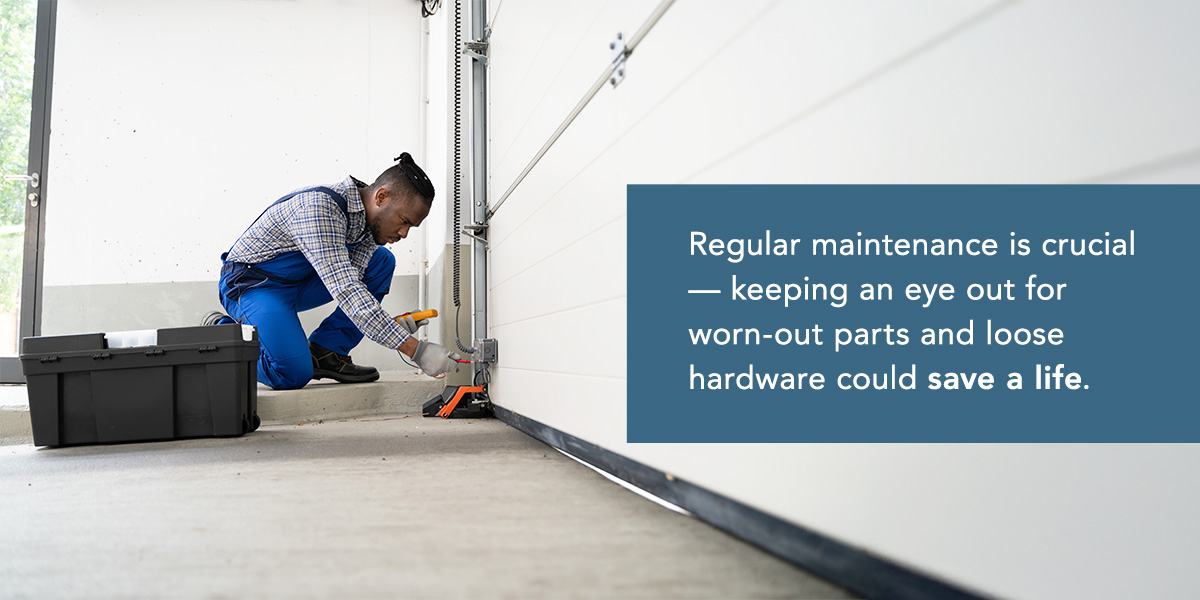
Regular maintenance is crucial — keeping an eye out for worn-out parts and loose hardware could save a life. However, more involved maintenance or repair is best left to a professional. DIY projects are all the rage in home improvement these days, but attempting garage door repairs yourself is dangerous. Garage doors, their springs and their tracks are incredibly heavy. Even if you’re working with a friend, the weight of these pieces can easily cause injury or even death. If your garage door needs to be repaired or replaced, call a professional garage door repair company.
8. Learn How to Operate Your Garage Door Manually
Power outages and malfunctions come without warning and could leave your garage door inoperable. Knowing how to operate it manually during these situations could save you, your family and your possessions and ensure you still have access to your car.
Your owner’s manual provides all the information needed to operate your garage door manually. However, there are some simple steps to keep in mind:
- Use the emergency release cord to disconnect the garage door from the automatic opener system.
- Always use the small handles on the bottom of your garage door when operating it.
- Garage doors are heavy, so lift with your legs and brace yourself for that weight when lowering them.
- Open and close your garage door gently to avoid it jumping off the tracks.
- Once the power is back, reconnect your garage door to the automatic opener system by pulling the emergency release cord and pulling it toward the opener.
When operating your garage door manually, keep it closed as often as possible to avoid it crashing down unexpectedly. Remember that without the automatic opener system, there aren’t any safety features you can rely on, so it’s still vital to keep your loved ones clear of the door while opening or closing it.
You must also manually lock it to prevent unwanted access.
Embrace Garage Door Safety With Kitsap Garage Door
One of the best things you can do to protect yourself and your family is to have a garage door maintenance and repair company you trust. At Kitsap Garage Door, our technicians are trained and experienced in handling many issues, meaning that they’re ready to provide the help you need whenever you need it.
We understand the importance of garage door safety and are committed to helping you stay safe. Serving the Kitsap Peninsula for over 45 years, we have a local reputation for bringing high-quality customer service and professionalism to each and every job. Contact us today to get professional assistance from one of our experienced technicians.
